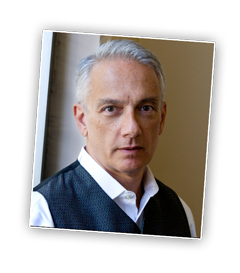

ERIC SHAQFEH
Stanford University
ENGINEERING FRACKING FLUIDS WITH COMPUTER SIMULATION
There are no comprehensive simulation-based tools for engineering the flows of viscoelastic fluid-particle suspensions in fully three-dimensional geometries. On the other hand, the need for such a tool in engineering applications, combined with the associated potential for understanding new physics related to elastic fluid/particulate suspensions is immense. Suspensions of rigid particles in viscoelastic fluids play key roles in many energy applications. For example, in oil drilling the "drilling mud" is a very viscous, viscoelastic fluid designed to shear-thin during drilling, but thicken at stoppage so that the "cuttings" can remain suspended. In a related application known as hydraulic fracturing suspensions of solids called "proppant" are used to prop open the fracture by pumping them into the well.
It is well-known that particle flow and settling in a viscoelastic fluid can be quite different from that which is observed in Newtonian fluids. There are many issues of importance in this context. First, it is now well known that the "fluid particle split" at bifurcation cracks is controlled by fluid rheology in a manner that is not understood. Second, in Newtonian fluids, the presence of an imposed shear flow in the direction perpendicular to gravity (which we term a cross or orthogonal shear flow) has no effect on the settling of a spherical particle in Stokes flow (i.e., at vanishingly small Reynolds number or inertial forces). By contrast, in a non-Newtonian liquid, the complex rheological properties induce a nonlinear coupling between the sedimentation and shear flow.
Recent experimental data have shown both the shear thinning and the elasticity of the suspending polymeric solutions significantly affects the fluid-particle split at bifurcations, as well as the settling rate of the solids. In the present work, we use unique computer simulations of viscoelastic flow in suspensions of spheres to study these problems. These simulations allow us to understand the detailed physical mechanisms for the remarkable physical behavior seen in practice, and actually suggest design rules for creating the new fluid recipes.
Date/Time |
Location 200 College Street Wallberg Building Room 116 |
 ERIC SHAQFEH is the Lester Levi Carter Professor of Chemical Engineering at Stanford University. He joined Stanford’s faculty in 1990after earning a B.S.E. summa cum laude from Princeton University (1981), and an M.S. (1982) and Ph.D. (1986) from Stanford University. He also completed postdoctoral work at the Department of Applied Mathematics and Theoretical Physics at U. Cambridge (1986) and was a Member of Technical Staff at ATT Bell Labs (1987-1990). In 2001 he received a dual appointment and became Professor of Mechanical Engineering. He is most recently (as of 2004) a faculty member in the Institute of Computational and Mathematical Engineering at Stanford.
ERIC SHAQFEH is the Lester Levi Carter Professor of Chemical Engineering at Stanford University. He joined Stanford’s faculty in 1990after earning a B.S.E. summa cum laude from Princeton University (1981), and an M.S. (1982) and Ph.D. (1986) from Stanford University. He also completed postdoctoral work at the Department of Applied Mathematics and Theoretical Physics at U. Cambridge (1986) and was a Member of Technical Staff at ATT Bell Labs (1987-1990). In 2001 he received a dual appointment and became Professor of Mechanical Engineering. He is most recently (as of 2004) a faculty member in the Institute of Computational and Mathematical Engineering at Stanford.
Shaqfeh’s current research interests include non-Newtonian fluid mechanics (especially in the area of elastic instabilities, and turbulent drag reduction), nonequilibrium polymer statistical dynamics (focusing on single molecules studies of DNA), and suspension mechanics (particularly of fiber suspensions and particles/vesicles in microfluidics). He has authored or co-authored over 170 publications and has been an Associate Editor of the Physics of Fluids since 2006.
Shaqfeh has received the APS Francois N. Frenkiel Award 1989, the NSF Presidential Young Investigator Award 1990, the David and Lucile Packard Fellowship in Science and Engineering 1991, the Camile and Henry Dreyfus Teacher--Scholar Award 1994, the W.M. Keck Foundation Engineering Teaching Excellence Award 1994, the 1998 ASEE Curtis W. McGraw Award, and the 2011 Bingham Medal from the Society of Rheology. A Fellow of the American Physical Society (2001) and a member of the National Academy of Engineering (2013), he has held a number of professional lectureships, including the Merck Distinguished Lectureship, Rutgers (2003), the Corrsin Lectureship, Johns Hopkins (2003) and the Katz Lectureship, CCNY (2004). He was also the Hougen Professor of Chemical Engineering at the University of Wisconsin (2004) and the Probstein Lecturer at MIT (2011).
Eric has been married to Terhilda Garrido for 32 years, and they have two children, Stefan, 26, and Elena, 22.
| For more info about this series: www.chem-eng.utoronto.ca |
Websites of Interest
- University of Toronto
- Faculty of Applied Science & Engineering
- Department of Chemical Engineering & Applied Chemistry
